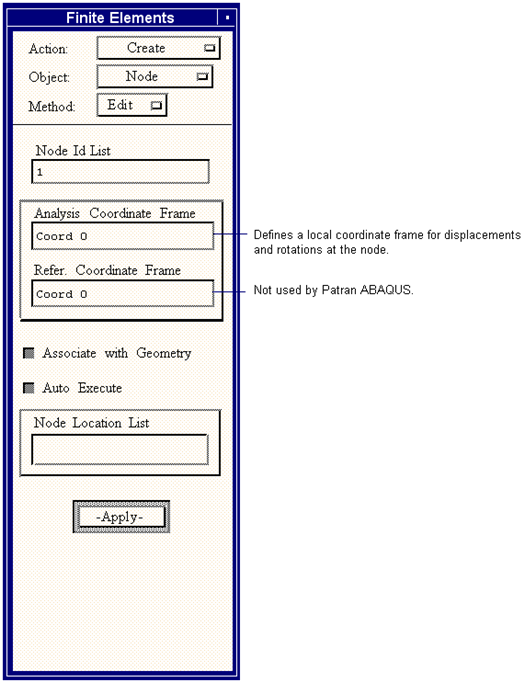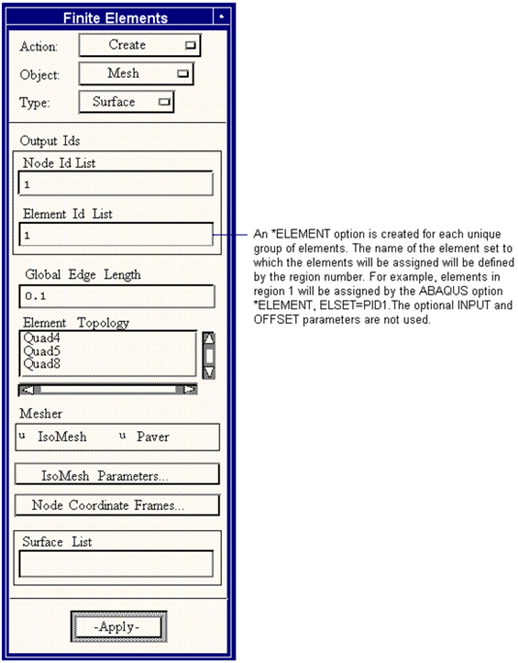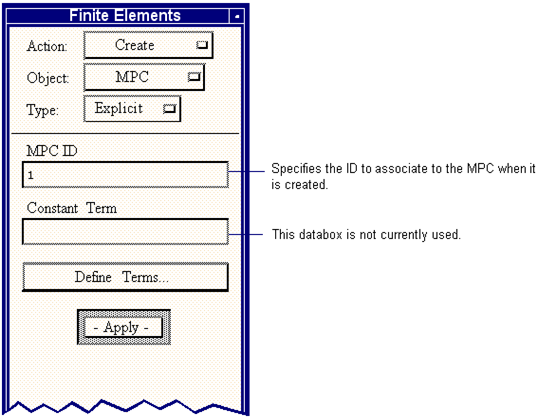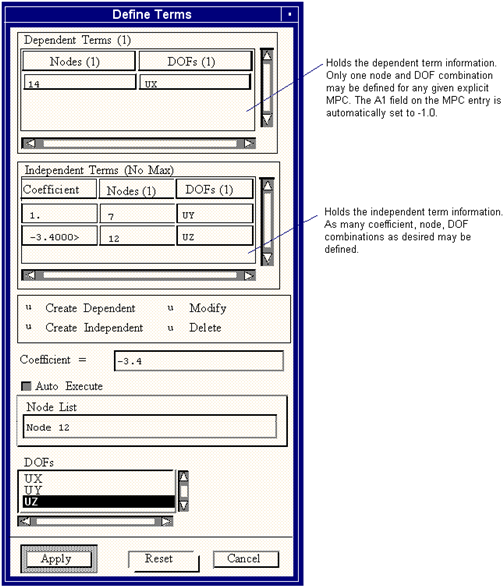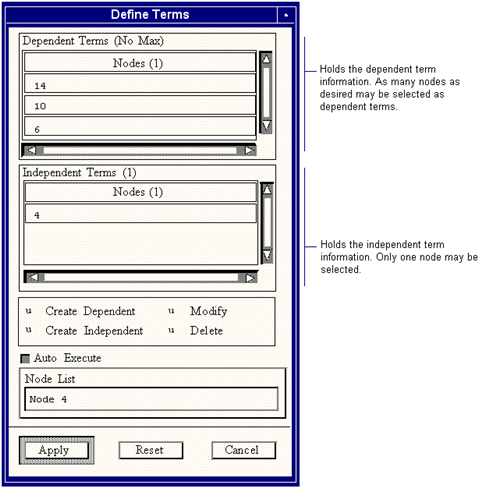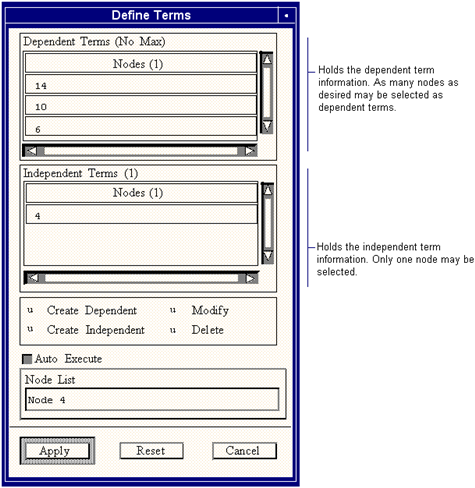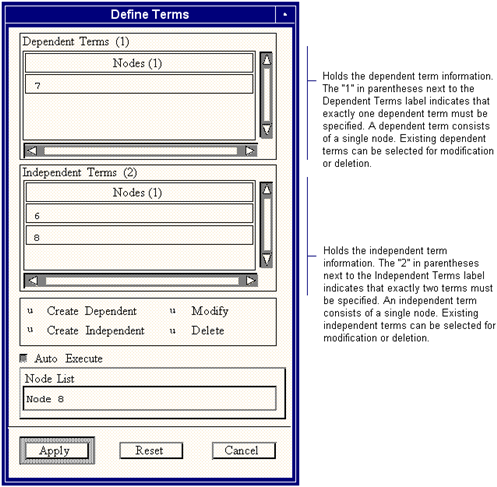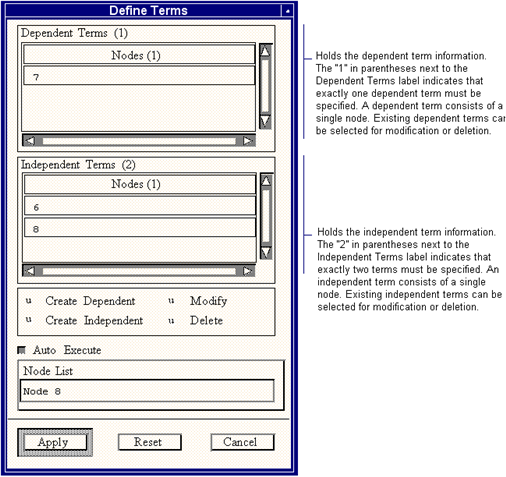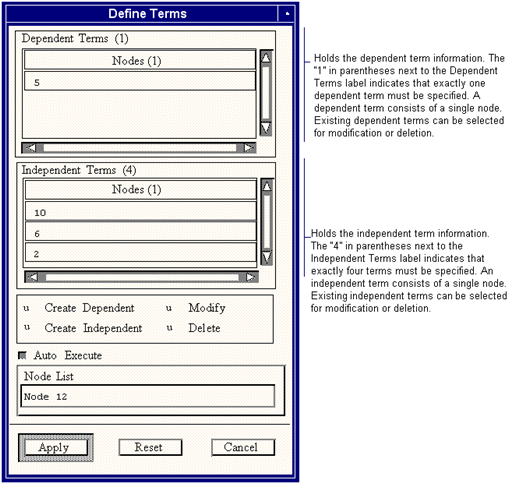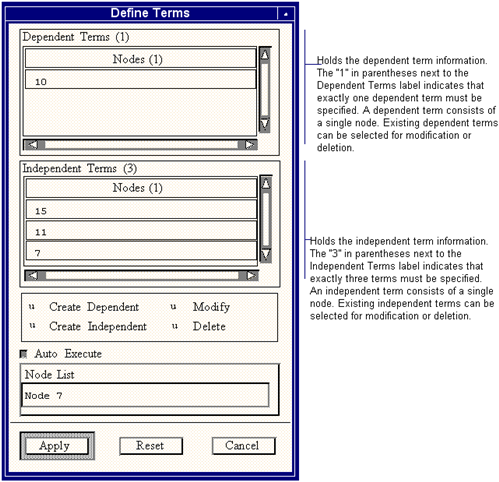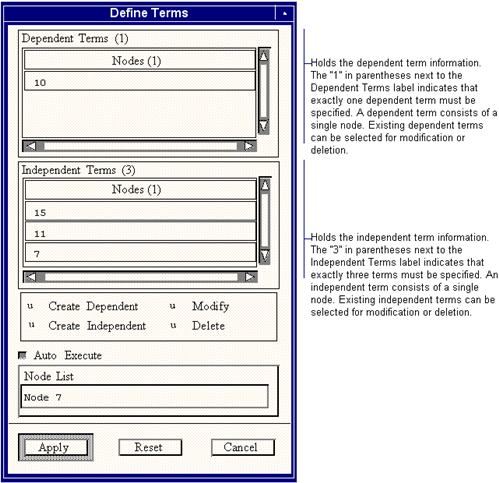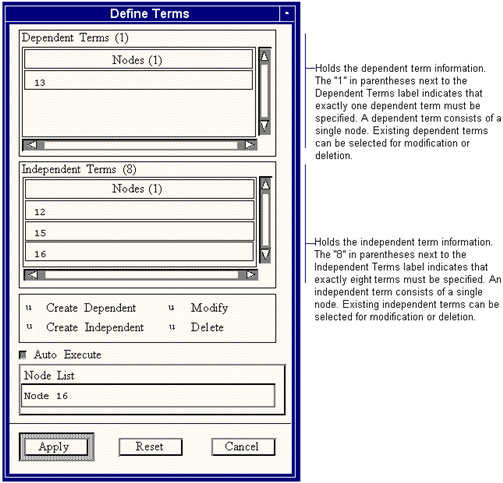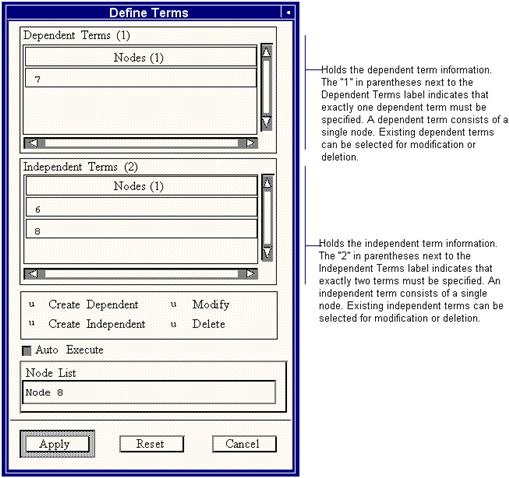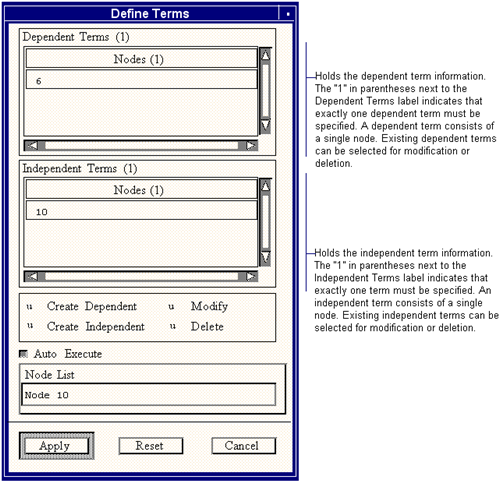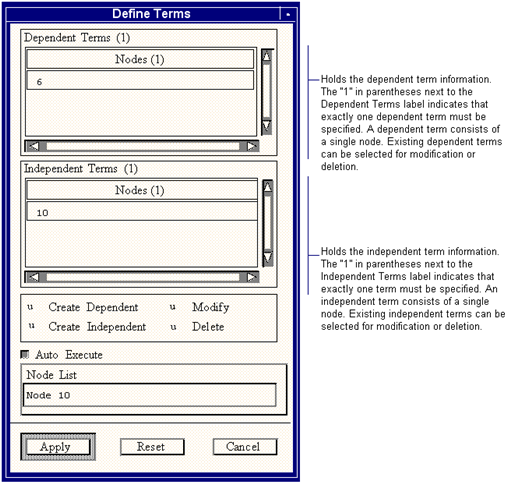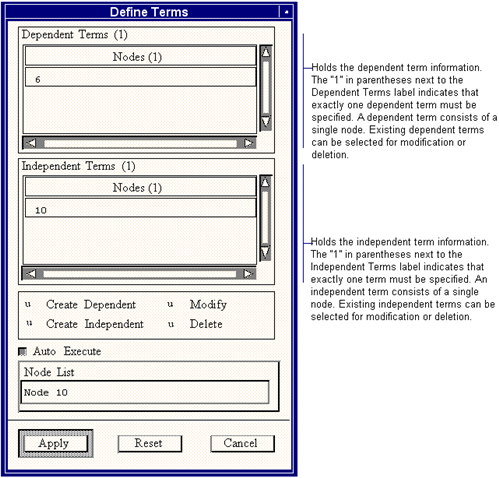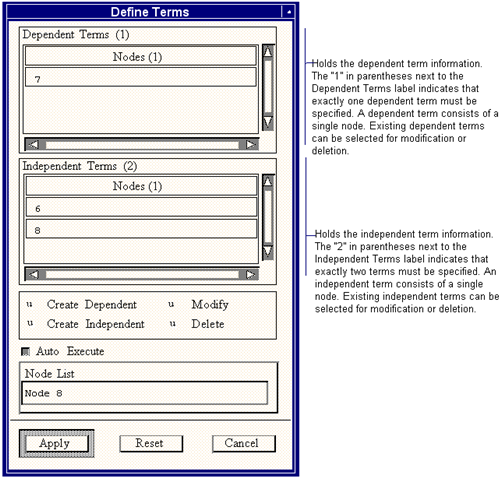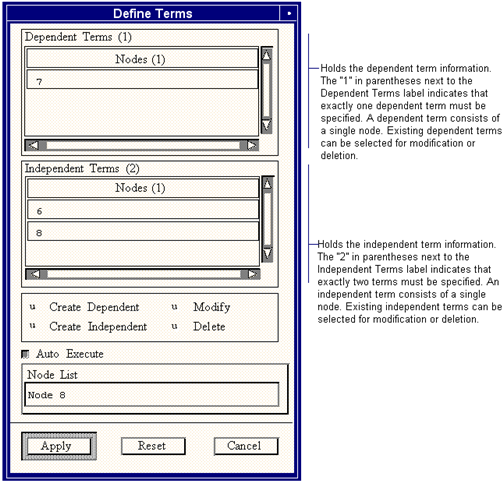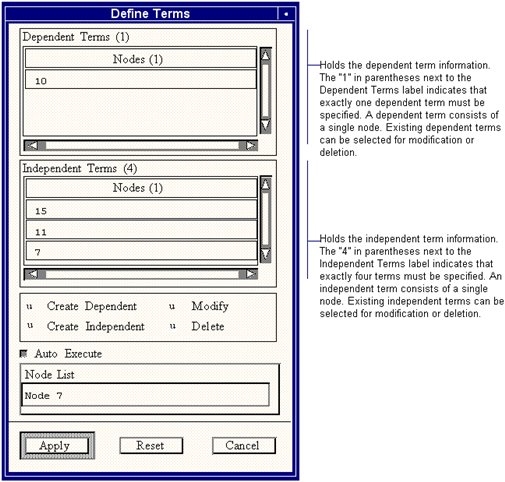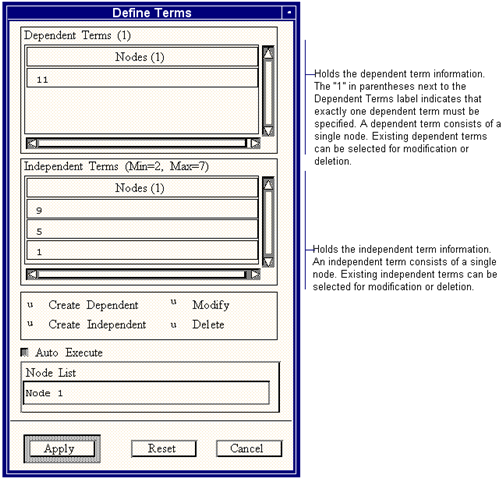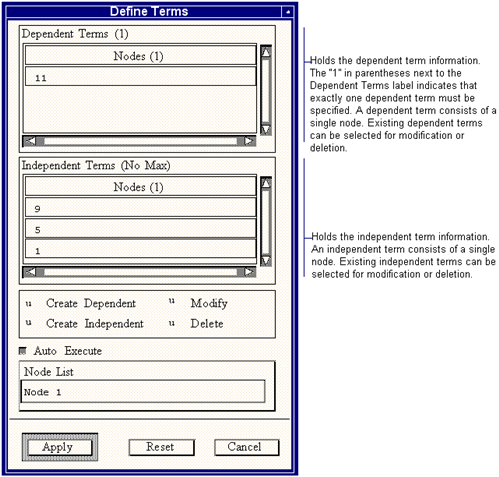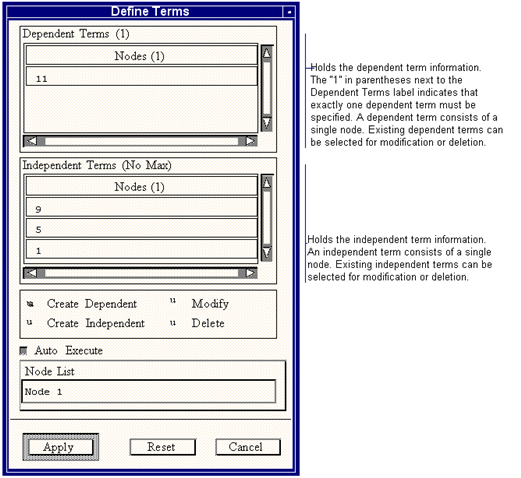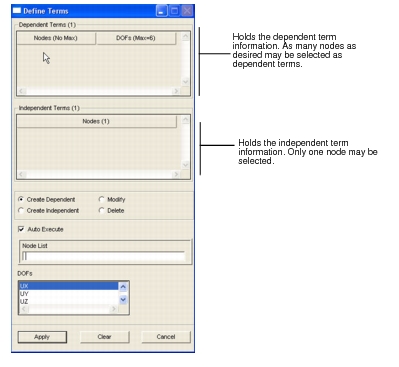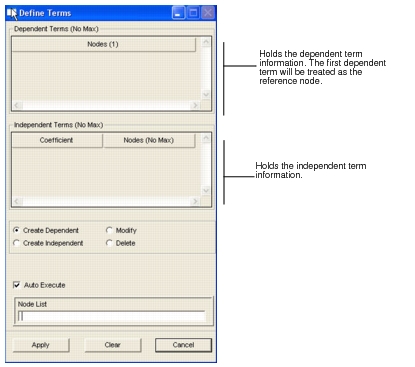XXXXXXXXXXXXXXXXXXXXXXXXXXXXXXXXXXXXXXXXXXXXXXXXXXXXXXXXXXXXXXXXXXXXXXXXXXXXXXXXXXXXXXXXXXXXXXXXXXXXXXXXXXXXXXXXXXXXXXXXXXXXXXXXXXXXXXXXXXXXXXXXXXXXXXXX''"> Finite Elements
Finite Elements in Patran allows the definition of basic finite element constructs, including the creation of nodes, element topology, and multi-point constraints.
Nodes
The nodes form will generate the ∗NODE option (see Section 7.3.6 in the ABAQUS / Standard
User’s Manual).
The name of the node set to which the nodes will be assigned will be based on the associated analysis coordinate frame number. For example, creating nodes in analysis coordinate frame “Coord 1" will generate the ABAQUS option ∗NSET, NSET=CID1.
Elements
Finite elements in Patran simply assigns element topology, such as Quad⁄4, for standard finite elements. The type of element to be created is not determined until the element properties are assigned. See
Element Properties Form for details concerning the ABAQUS element types. Elements can be created either discretely using the Element object, or indirectly using the Mesh object.
Multi-Point Constraints
Multi-point constraints (MPCs) can also be created from the Finite Elements menu. These are special element types which define a rigorous behavior between several specified nodes. The forms for creating MPCs are found by selecting MPC as the Object on the Finite Elements form. The full functionality of the MPC forms are defined in
Create Action (FEM Entities) (Ch. 3) in the Reference Manual - Part III.
MPC Types
To create an MPC, you must first select the type of MPC you want to create from an option menu. The types that will appear in this option menu are dependent on the current Analysis Type preference setting. The following table describes the MPC types that are supported.
MPC Type | Analysis Type | Description |
| Structural Thermal | Creates an ∗EQUATION option which defines an explicit MPC between a dependent degree-of-freedom and one or more independent degrees-of-freedom. The dependent term consists of a node ID and a degree-of-freedom, while an independent term consists of a coefficient, a node ID, and a degree-of-freedom. An unlimited number of independent terms and one dependent term can be specified. |
| Structural | Creates a BEAM type MPC between one independent node and one or more dependent nodes in which all six structural degrees-of-freedom are rigidly attached to each other. An unlimited number of dependent terms and one independent term can be specified. Each term consists of a single node. |
| Structural | Creates a LINK type MPC between one independent node and one or more dependent nodes in which only the three translational structural degrees-of-freedom are rigidly attached to each other. An unlimited number of dependent terms and one independent term can be specified. Each term consists of a single node. |
| Structural Thermal | Creates a LINEAR type MPC between a dependent node on one linear 2D element and two independent nodes on another linear 2D element to model a continuum. One dependent and two independent terms can be specified. Each term consists of a single node. |
| Structural | Creates an SS LINEAR type MPC between a dependent node on a linear 2D plate element and two independent nodes on a linear 3D solid element to connect the plate element to the solid element. One dependent and two independent terms can be specified. Each term consists of a single node. |
| Structural Thermal | Creates a BILINEAR type MPC between a dependent node on one linear 3D solid element and four independent nodes on another linear 3D solid element to model a continuum. One dependent and four independent terms can be specified. Each term consists of a single node. |
| Structural | Creates a QUADRATIC type MPC between a dependent node on one quadratic 2D element and three independent nodes on another quadratic 2D element to model a continuum. One dependent and three independent terms can be specified. Each term consists of a single node. |
| Structural | Creates an SS BILINEAR type MPC between a dependent node on a quadratic 2D plate element and three independent nodes on a quadratic 3D solid element to connect the plate element to the solid element. One dependent and three independent terms can be specified. Each term consists of a single node. |
| Structural | Creates a C BIQUAD type MPC between a dependent node on one quadratic 3D solid and eight independent nodes on another quadratic 3D solid element to model a continuum. One dependent and eight independent terms can be specified. Each term consists of a single node. |
| Structural | Creates a SLIDER type MPC between one dependent node and two independent nodes which forces the dependent node to move along the vector defined by the two independent nodes. One dependent and two independent terms can be specified. Each term consists of a single node. |
| Structural | Creates an ELBOW type MPC which constrains two nodes of ELBOW31 or ELBOW32 elements together. One dependent and one independent terms can be specified. Each term consists of a single node. |
| Structural | Creates a TIE type MPC which makes all active degrees-of-freedom equal at two nodes. One dependent and one independent terms can be specified. Each term consists of a single node. |
| Structural | Creates a REVOLUTE type MPC which defines a revolute joint. One dependent and two independent terms can be specified. Each term consists of a single node. |
| Structural | Creates a V LOCAL type MPC which constrains the velocity components at the first node to be equal to the velocity components at the third node along local, rotating, directions. These local directions rotate according to the rotation at the second node. One dependent and two independent terms can be specified. Each term consists of a single node. |
| Structural | Creates a UNIVERSAL type MPC which defines a universal joint. One dependent and three independent terms can be specified. Each term consists of a single node. |
| Structural | Creates an SS LINEAR type MPC which constrains a shell node to a line of solid nodes for linear elements. One dependent and an unlimited number of independent terms can be specified. Each term consists of a single node. |
| Structural | Creates an SS BILINEAR type MPC which constrains a shell node to a line of solid nodes for quadratic elements. One dependent and an unlimited number of independent terms can be specified. Each term consists of a single node. |
| Structural | Creates an SSF BILINEAR type MPC which constrains a mid-side shell node to a line of mid-face solid nodes for quadratic elements. One dependent and an unlimited number of independent terms can be specified. Each term consists of a single node. |
RBE 2 | Structural | |
RBE 3 | Structural | |
Degrees-of-Freedom
Whenever a list of degrees-of-freedom is expected for an MPC term, a listbox containing the valid degrees-of-freedom is displayed on the form. A degree-of-freedom is valid if:
1. It is valid for the current Analysis Type Preference.
2. It is valid for the selected MPC type.
In most cases, all degrees-of-freedom which are valid for the current Analysis Type preference are valid for the MPC type.
The following degrees-of-freedom are supported by the Patran ABAQUS MPCs for the various
analysis types:
Degrees-of-Freedom | Analysis Type |
UX | Structural |
UY | Structural |
UZ | Structural |
RX | Structural |
RY | Structural |
RZ | Structural |
Temperature | Thermal |
Note: | Care must be taken to make sure that a degree-of-freedom selected for an MPC actually exists at the nodes. For example, a node that is attached only to solid structural elements will not have any rotational degrees-of-freedom. However, Patran will allow you to select rotational degrees-of-freedom at this node when defining an MPC. |
Explicit MPCs
Creates an *EQUATION option. (See Section 7.8.3 in the ABAQUS/Standard User’s Manual). No constant term is allowed for this type of equation. The A1 multiplier for the dependent term will be set to -1.0 to create the desired equation.
Rigid (Fixed) MPCs
Creates an *MPC option of type BEAM for each dependent node (see Section 7.8.4 in the ABAQUS/Standard User’s Manual). This provides a rigid beam between two nodes to constrain the displacement and rotation at the first node to the displacement and rotation at the second node, corresponding to the presence of a rigid beam between the two nodes.
Rigid (Pinned) MPCs
Creates an *MPC of type LINK for each dependent node (see Section 7.8.4 in the ABAQUS/Standard User’s Manual). This provides a pinned rigid link between two nodes in order to keep the distance between the two nodes constant. The displacements of the first node are modified to enforce this constraint. The rotations at the nodes, if any, are not involved in this constraint.
Linear Surf-Surf MPCs
Creates an *MPC option of type LINEAR (see Section 7.8.4 in the ABAQUS/Standard User’s Manual). This is the standard method for mesh refinement of first-order elements.
This MPC constrains each degree-of-freedom at the dependent node to be interpolated linearly from the corresponding degrees-of-freedom at the independent nodes
.
Note: | Linear Surf-Surf and Linear Surf-Vol MPCs both generate the ABAQUS ∗MPC type LINEAR. |
Linear Surf-Vol MPCs
Creates an *MPC option of type SS LINEAR (see Section 7.8.4 in the ABAQUS/Standard User’s Manual).
This is the standard method for mesh refinement of first-order elements. This MPC constrains each degree-of-freedom at the dependent node to be interpolated linearly from the corresponding degrees-of-freedom at the independent nodes.
Note: | Linear Surf-Surf and Linear Surf-Vol MPCs both generate the ABAQUS ∗MPC type SS LINEAR. |
Linear Vol-Vol MPCs
Creates an *MPC option of type BILINEAR (see Section 7.8.4 in the ABAQUS/Standard User’s Manual). This is a standard method for mesh refinement of first-order solid elements in three dimensions.
This MPC constrains each degree-of-freedom at the dependent node to be interpolated bilinearly from the corresponding degrees-of-freedom at the independent nodes.
Quad. Surf-Surf MPCs
Creates an *MPC option of type QUADRATIC (see Section 7.8.4 in the ABAQUS/Standard User’s Manual). This is a standard method for mesh refinement of second-order elements.
This MPC constrains each degree-of-freedom at the dependent node to be interpolated quadratically from the corresponding degrees-of-freedom at the independent nodes.
Note: | Quad Surf-Surf and Quad Surf-Vol MPCs both generate the ABAQUS *MPC type QUADRATIC |
Quad. Surf-Vol MPCs
Creates an *MPC option of type SS BILINEAR (see Section 7.8.4 in the ABAQUS/Standard User’s Manual). This is a standard method for mesh refinement of second-order elements.
This MPC constrains each degree-of-freedom at the dependent node to be interpolated quadratically from the corresponding degrees-of-freedom at the independent nodes.
Note: | Quad Surf-Surf and Quad Surf-Vol MPCs both generate the ABAQUS ∗MPC type SS BILINEAR. |
Quad. Vol-Vol MPCs
Creates an *MPC option of type C BIQUAD (see Section 7.8.4 in the ABAQUS/Standard User’s Manual). This is a standard method for mesh refinement of second-order solid elements in three dimensions.
This MPC constrains each degree-of-freedom at the dependent node to be interpolated by a constrained biquadratic from the corresponding degrees-of-freedom at the eight independent nodes.
Slider MPCs
Creates an *MPC option of type SLIDER (see Section 7.8.4 in the ABAQUS/Standard User’s Manual).
This MPC will keep a node on a straight line defined by two other nodes, but allows the possibility of moving along the line, and the line to change length.
Elbow MPCs
Creates an *MPC option of type ELBOW (see Section 7.8.4 in the ABAQUS/Standard User’s Manual). This MPC constrains two ELBOW31 or ELBOW32 elements together, where the cross-sectional direction changes.
Pin MPCs
Creates an *MPC option of type PIN (see Section 7.8.4 in the ABAQUS/Standard User’s Manual). This MPC provides a pinned joint between two nodes. This makes the displacements equal, but leaves the rotations, if they exist, independent of each other.
Tie MPCs
Creates an *MPC option of type TIE (see Section 7.8.4 in the ABAQUS/Standard User’s Manual). This MPC makes all active degrees-of-freedom equal at two nodes.
If there are different degrees-of-freedom active at the two nodes, only those in common will be constrained. It is usually used to join two parts of a mesh when corresponding nodes on the two parts are to be fully connected.
Revolute MPCs
Creates an *MPC option of type REVOLUTE (see Section 7.8.4 in the ABAQUS/Standard User’s Manual).
V Local MPCs
Creates an *MPC option of type V LOCAL (see Section 7.8.4 in the ABAQUS/Standard User’s Manual).
Universal MPCs
Creates an *MPC option of type UNIVERSAL (see Section 7.8.4 in the ABAQUS/Standard
User’s Manual).
SS Linear MPCs
Creates an *MPC option of type SS LINEAR (see Section 7.8.4 in the ABAQUS/Standard User’s Manual). This MPC is used to constrain a shell node to a solid node line for linear elements (S4R or S4R5; C3D8, C3D8R; SAX1; CAX4; etc.) or for midside lines on quadratic elements (S8R, S8R5; C3D20, C3D20R; etc.).
This MPC is only valid for small rotations.
SS Bilinear MPCs
Creates an *MPC option of type SS BILINEAR (see Section 7.8.4 in the ABAQUS/Standard User’s Manual). This MPC is used to constrain a corner node of a quadratic shell element (S8R, S8R5) to a line of edge nodes on 20-node bricks.
This MPC is only valid for small rotations.
SSF Bilinear MPCs
Creates an *MPC option of type SSF BILINEAR (see Section 7.8.4 in the ABAQUS/Standard User’s Manual). This MPC is used to constrain a corner node of a quadratic shell element (S8R, S8R5) to a line of edge nodes on 20-node bricks.
This MPC is only valid for small rotations.
RBE2
Creates *KINEMATIC COUPLING options. Creates a rigid body with independent degrees-of-freedom that are specified at a single grid point and with dependent degrees-of-freedom that are specified at an arbitrary number of grid points.
RBE3
Creates *DISTRIBUTING COUPLING. options. Defines the motion at a reference grid point as the weighted average of the motions at a set of other grid points


